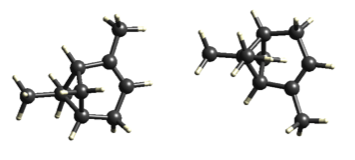Pinene – It's beginning to smell a lot like Christmas!
What does it look like?

Pinene crystallises in an Orthorhombic P212121 space group. Graphics created using CrystalExplorer.
What is it?

As I write this post, sitting in a very wintery northern hemisphere, the nights are drawing in and the temperature is dropping to the low single figures (being the UK, it is also raining, but we'll try to forget that bit). However, being a native to these shores, there's nothing quite like it to make you feel like Christmas is getting close.
A decorated Christmas tree, with its twinkling lights and colourful decorations, is probably one of the most iconic Christmas images. Although it may be unwise to start a debate about the merits of natural vs. artificial, it is hard to deny that a fresh tree definitely wins in the scent department.
That smell comes from Pinene. Pinene is a naturally occurring hydrocarbon, part of the terpene family, and is most commonly found in tree resin – the thick, sticky liquid secreted by conifers when they've been cut or wounded. Pinene is predominantly used by these trees to seal and protect wounds, and to act as a repellent to harmful insects. Pinene is also found in many essential oils (such as ironwort or sage), used as flavour additives in food, perfumery and in medicines and alternative medicines. It is also the main component of turpentine paint thinner, and can be used as a feedstock for jet fuel!
Where did it come from?
This structure was determined and published by Andrew Bond and John Davies of the University of Cambridge in 2001 (A. D. Bond, J. E. Davies, Acta Cryst. (2001), E57, o1039). Graphics were produced using CrystalExplorer. Further facts were also found on http://www.explorecuriocity.org.






